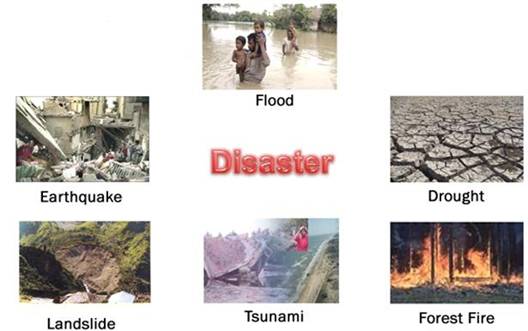 |
|
| Home | Seasons & Varieties | Tillage | Nutrient Mgmnt | Irrigation Mgmnt | Weed Mgmnt | Crop Protection | Cost of Cultivation | Photobank | |
Major Areas :: Disaster - An Introduction |
|
DISASTER- An introduction
The term disaster owes its origin to the French word “Desastre” which is a combination of two words ‘des’ meaning bad and ‘aster’ meaning star. Thus the term refers to ‘Bad or Evil star’. A disaster can be defined as “A serious disruption in the functioning of the community or a society causing wide spread material, economic, social or environmental losses which exceed the ability of the affected society to cope using its own resources”. A disaster is a result from the combination of hazard, vulnerability and insufficient capacity or measures to reduce the potential chances of risk. A disaster happens when a hazard impacts on the vulnerable population and causes damage, casualties and disruption. Any hazard – flood, earthquake or cyclone which is a triggering event along with greater vulnerability (inadequate access to resources, sick and old people, lack of awareness etc) would lead to disaster causing greater loss to life and property. For example; an earthquake in an uninhabited desert cannot be considered a disaster, no matter how strong the intensities produced. Hazard may be defined as “a dangerous condition or event, that threat or have the potential for causing injury to life or damage to property or the environment.” The word ‘hazard’ owes its origin to the word ‘hasard’ in old French and ‘az-zahr’ in Arabic meaning ‘chance’ or ‘luck’. Hazards can be grouped into two broad categories namely natural and manmade. 1. Natural hazards are hazards which are caused because of natural phenomena
(hazards with meteorological, geological or even biological origin).
Examples of natural hazards are cyclones, tsunamis, earthquake and volcanic eruption which are exclusively of natural origin. Landslides, floods, drought, fires are socio-natural hazards since their causes are both natural and man made. For example flooding may be caused because of heavy rains, landslide or blocking of drains with human waste. 2. Manmade hazards are hazards which are due to human negligence. Manmade hazards are associated with industries or energy generation facilities and include explosions, leakage of toxic waste, pollution, dam failure, wars or civil strife etc. The list of hazards is very long. Many occur frequently while others take place occasionally. However, on the basis of their genesis, they can be categorized as follows: |
|
| Home | Seasons & Varieties | Tillage | Nutrient Management | Irrigation Management | Weed Management | Crop Protection | Cost of Cultivation | Photobank| Disclaimer
© All Rights Reserved. TNAU-2015 |
|
